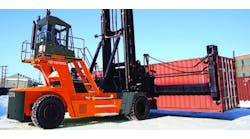Reshaping the Future of Intermodal Operations: Insights from a Rail Industry Leader
Carrie Ann Crozier, a seasoned veteran of the rail industry, was appointed as the Vice President of Intermodal Operations at CSX in January 2024. With over two decades of experience spanning various operational roles, Crozier brings a wealth of expertise to her current position overseeing the company's 40+ intermodal terminals.
Prior to joining CSX, Crozier held leadership positions at Canadian National Railway (CN), where she managed the railroad's intermodal ports, terminals, and trucking operations. Her career journey began as an intermodal operations employee, providing her with invaluable hands-on experience and a deep understanding of field-level operations.
In this Q&A, Crozier discusses her motivations for joining CSX, the key initiatives she has spearheaded to drive operational excellence, and her perspectives on navigating recent industry disruptions. Her insights underscore her commitment to developing people, leveraging data-driven decision making, and positioning CSX as a leader in the evolving freight transportation landscape.
Q: What interested you in coming to CSX?
A: My interest in joining CSX was sparked by the company's cultural transformation, which is focused on its commitment to fostering a strong sense of teamwork, and its growth potential. CSX plays an important role in trade, particularly along the East Coast and in heavily populated regions, making it a key player that’s poised for substantial growth.
Throughout my career in the rail industry—a journey that began during my university days and extends through a family history in rail—I have faced various challenges, particularly as a woman in transportation. Although, at times, you feel you like you’re a trailblazer in various ways, there came a time when I felt ready for a new chapter. CSX presented itself as that perfect opportunity. The leadership team at CSX is not only experienced but also genuine in their approach; and the company’s focus on improving both employee and customer experiences, coupled with its dedication to diversity and inclusion, aligns seamlessly with my desire to contribute to a meaningful and dynamic workplace.
Being part of CSX means being part of a team that is rewriting the narrative of rail culture, and I am excited for the opportunity to make a difference by bringing a diverse perspective and working towards shared goals. The CSX story is one of evolution and positive change, and I am glad to be a part of it.
Q: When you first started in this role, what areas did you think you would be able to make the biggest impact on?
A: When I first stepped into this role, I saw an opportunity to leverage the fact that I’m very process-driven and have diverse experience across operations, network planning, and supply chain to make a significant impact. My background equips me with a comprehensive understanding of the business, that enables me to evaluate situations from both an outside-in and inside-out perspective, which I believe is crucial for driving meaningful change.
At CSX, I am fortunate to work within a collaborative and innovative team environment. The team here is exceptional—everyone is eager to try new things and open to feedback, which creates a vibrant atmosphere for experimentation and growth. With such a strong core team, we have the freedom to explore different approaches and implement positive change in our processes. It's truly exciting to be part of a group that is not only skilled but also willing to embrace new ideas and eager to help drive the company forward.
Q: Can tell me about some of those changes? What are some things that you've started to do or some things that you're looking to do?
A: Right off the hop, one of the most significant projects I undertook was addressing the challenges at the Fairburn intermodal terminal in Georgia. Initially, Fairburn had a history of underperformance, often standing out as an outlier in intermodal standards. I was asked by both the company and our customers for my insights on how we could improve its operations.
It’s an impressive terminal – technologically advanced, on a beautiful plot of land, and well-positioned near Atlanta where you see so many trucks driving through that can be taken off the road to ease traffic. Recognizing its immense potential, we quickly implemented several strategic changes.
We began by revisiting the operating plan, making swift adjustments that, while not revolutionary, were essential. By collaborating with talented individuals across the CSX network—from operations to commercial teams—we tackled each area of opportunity methodically. This process started with a comprehensive whiteboard listing 36 target areas, which we addressed systematically, resulting in rapid improvements that received positive feedback from our customers.
One of our key achievements was transforming truck turn times at Fairburn from industry lagging to best-in-class. This improvement enhanced the overall experience for truckers and unlocked additional capacity in what was previously thought to be a fully utilized terminal. This newfound capacity allowed us to better handle disruptions and support growth, especially with key partners.
The success at Fairburn has been a blueprint for other terminals. We've applied these best practices to places like Winter Haven in Florida, which is like a "Fairburn 2.0." It’s one of our terminals in Orlando. There we witnessed significant improvements in customer experience and throughput. There are opportunities like this across our vast network, in areas like New Jersey, Baltimore, and Philadelphia, where similar strategies can drive growth and operational excellence.
What excites me most is the untapped potential within CSX's extensive network. The opportunity to explore and expand these strategic initiatives has been both challenging and rewarding.
Q: Mike Cory, CSX’s EVP and Chief Operating Officer, talks about the complexities of the CSX network. Does that impact intermodal and is that something that you’ve had to comb through?
A: Yes, indeed, it’s a complex network! I’m used to a linear network—like East, West, North, South—so my previous experience is completely different. However, I've come to appreciate its intricacies.
Our business thrives on having multiple access points, which are essential for meeting diverse logistical needs. This complexity is a competitive advantage, especially when it comes to converting truck freight to rail. Bringing goods into urban centers, even if they are relatively close in distance, is a critical aspect of our operation and represents a significant opportunity.
Navigating the intermodal aspect of this network involves understanding and managing 31 terminals along with 14 port operations. Each of these 45 locations brings its own set of challenges and learning curves but mastering them is important for our success in the competitive landscape. This complexity is precisely what enables us to provide superior service and flexibility to our customers.
Q: What are some of the other items that you're looking at addressing or looking to help improve as we move forward?
A: Our strategic focus moving forward is centered on a few key areas. First, leveraging data more strategically is imperative. This involves using data to enhance our forecasting capabilities and align our objectives with actual results. We've undertaken a comprehensive review of our equipment across all terminals, identifying best practices and setting benchmarks for optimal operation. As a result, we've significantly reduced our equipment footprint, which enhances our resilience, ensures continuity, and improves access to quality maintenance and repair services.
One of my primary focuses is the continuous development of our people. We've restructured our teams by adding resources, promoting from within, and bringing in external talent with diverse backgrounds and expertise. This approach has helped us create a team that's not only operationally focused but also aligned with our commercial and service partners. To seize business opportunities, we have to embrace diversity of thought and experience, challenging ourselves to innovate and adapt.
My time is largely dedicated to developing our teams and practices, ensuring that every team member feels engaged, valued, and safe. It's crucial to foster an environment where individuals can excel and continually grow. Celebrating our successes and identifying opportunities for improvement are essential parts of our culture. For example, during a recent visit to the Jacksonville ramp with key leaders and employees, we spent time emphasizing the positive aspects of our operations and sought employee feedback on potential opportunities rather than focusing on issues. It’s important to have these types of engagements with the team and recognize their contributions.
Q: You're involved in a couple of mentoring programs as well, in addition to the day to day. Can you talk about those?
A: In addition to my daily responsibilities, I'm involved in mentoring programs that provide positive experiences both for me and for those I mentor. Through the United Way Stein Fellowship, I've had the privilege of mentoring a local young professional in Jacksonville. My current mentee is someone from a different industry, still early in her career. It's an incredible opportunity to provide guidance and share insights across sectors, and I was eager to participate when asked.
I am also involved with the Creative Destruction Lab (CDL) at the University of Montreal, where I mentor innovators and entrepreneurs four times a year, working alongside experts from diverse fields like technology, supply chain, and emerging business ventures. This initiative has been particularly rewarding, allowing me to mentor numerous individuals—last year alone, I guided around 14 mentees.
A significant focus of mine is addressing the underrepresentation of women in the rail industry, particularly in operations. Having been down this path myself, I feel a strong responsibility to give back and help pave the way for other women. I'm passionate about creating an environment where women can advance without facing unnecessary barriers. Collaborating with Diana Sorfleet, CSX's EVP and Chief Administrative Officer, we've sponsored initiatives that empower women in rail. These efforts have inspired a network of cross-functional and cross-railway female leaders to come together and carve meaningful paths forward. This collaborative endeavor represents an exciting opportunity to make substantial progress in gender representation in our industry.
Q: How did you and your team respond to the recent storms and the port worker’s strike, which required operations to be restructured on the intermodal side?
A: Our team adopted a strategic and proactive approach to managing operations. Rather than following the typical procedure of gradually winding down operations in anticipation of the strike, we maintained rail activities right up until the labor disruption occurred. This was possible due to our strong network condition and terminal capacity, which allowed us to keep operations fluid.
We built resilience at our terminals by continuing to receive traffic, staging it efficiently. This approach minimized the supply chain shock, enabling a smoother shutdown and a more agile startup once the strike ended. By having a backlog of staged traffic, we were prepared to resume operations quickly and effectively, reducing the impact on our partners, including trucking companies and customers involved in the first and last miles of intermodal transport. This innovative approach turned a potential disruption into a non-event, thanks largely to our collaborative efforts with our commercial team, led by Maryclare Kenney, Vice President of Intermodal and Auto, and our supply chain partners. The controlled shutdown and restart during the International Longshoremen’s Association strike were exceptionally positive for the supply chain.
Regarding the hurricanes, our primary concern was the safety and well-being of our employees, who are essential to our resilience and recovery capabilities. Once their safety was secured, we executed our shutdown, recovery, and startup plans smoothly and efficiently through a collaborative effort with open communication both within our organization and with external partners. I personally engaged with key customers facing similar challenges, and our teams worked together to overcome obstacles. This all-inclusive, cooperative approach ensured that we navigated the disruptions effectively and maintained our service standards.
Q: Do you feel the stress of having to be the one who actually makes those calls and how do you manage those types of matters?
A: Managing stress in decision-making roles is something I've become accustomed to over the years. My experience has taught me that it's essential to pause and reassess whenever necessary, and make sure that we adapt our strategies with the right controls in place. This approach allows us to pivot without compromising safety or impacting others negatively. The key is to embrace the possibility that things might not always go as planned, and to view these moments as opportunities for innovation and growth.
What truly occupies my thoughts is the constant drive to refine our processes. I often ask myself how we could have improved, where my blind spots might be, and how we can leverage our successes to evolve continuously. Each situation presents a chance to identify areas to get better and recognize the small wins along the way.
Q: What are you most looking forward to in this role?
A: I am incredibly excited about the opportunity to realize our growth potential and refine our services further. I’m excited for us to embrace innovation, recognizing that using data and analytics will be important in driving a forward-looking strategy that keeps positioned as an industry leader. I am also enthusiastic about fostering the development and success of our talented team members, watching them thrive as they contribute to our shared goals.
Most of all, I am eager to witness the evolution of CSX as we strive to differentiate ourselves within the industry. I firmly believe that our efforts will not only enhance our position but also set new benchmarks for excellence across the sector. The future of CSX is bright, and I am thrilled to be a part of the journey that will redefine industry standards.
Sponsored by:





